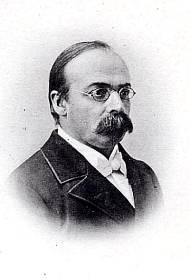
Arnold Fraefel 1843 - 1919
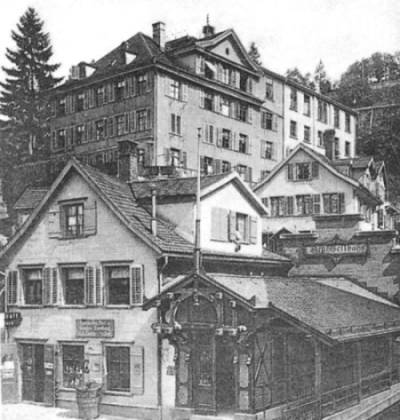
Fraefel & Co. in the city of
St. Gallen
| ANNE WANNER'S Textiles in History / Fraefel & Co |
| Fraefel & Co., a
Swiss manufacturer of vestments a paper, given at the CIETA meeting of 1987 in Lyon, France, by Anne Wanner-JeanRichard |
| page 1 of 2 next |
|
I. the Manufactory of Fraefel & Co. |
|
|
|
| see also | In 1883 Arnold Fraefel was advised to establish a company for producing religious embroideries. At this time Fraefel, the son of a school-teacher, was almost 40 years old. He had probably had some commercial training and like many others had also worked for some time in the textile industry. He was a man of many interests: from the beginning he installed in his house a photographic atelier with a glass roof and there he himself photographed the finished vestments. He also produced designs for embroideries. Arnold Fraefel died in 1919 and his son Gallus took over the company. Since 1958 the grandson Arnold has managed the firm. The third generation of manufacturers produced mainly badges and banners. The company was closed in 1983. |
The firm flourished most when it was led by the grandfather Arnold around 1910. At St. Gallen and in the branches in foreign countries, there were 175 people working for Fraefel & Co. Branches existed in: Karlsruhe and
Friedrichshafen in Germany and in the United
States in Toledo (Ohio), in Chicago and in New
York. In the United States they existed until 1929 under
the name Fraefel & Co. |
| Organisation of the embroidery manufactory: |
| In the firm of Fraefel &
Co. there were different departments: - In the design atelier, designs for hand and machine embroidery came into being. Around 1910 there were about 10 people working here. They had been educated in German Academies. Most important for them was to learn how to produce the human form. - Also around 1910 there were about 25 women working in the hand embroidery department. - In the sewing department vestments were now made from both handmade or machine made parts. In 1910 about 30 women worked here. - At this time there were about 25 chainstitch machines in the company building. - The hand machines however were not kept here. People
were contracted by the company to work at home and with
few exceptions only men worked on the handmachines. |
From the time of the
founding in 1883 all companys embroideries were well
documented: the designs were kept in large
folios (84cm x 56cm) and every subject was numbered. All
the finished vestments were photographed and the numbered
photos were kept in photo albums (60cm x 48cm). On the
basis of these photographs several catalogues were
printed. The travelling agents obtained their orders with
the help of these catalogues. Designs could be executed many times and therefore the same patterns were in use for many years. This fact makes it impossible to date the individual embroidery exactly. The works of the Fraefel company can be devided into 3 groups: - earliest creations, from 1883 to the First World War |
| Embroidery techniques of Fraefel & Co. |
When the Fraefel company was closed in 1983 there remained some documents and some embroidered patterns. Not all of them originated in the 19th century, but in the 100 years of existence of Fraefel & Co., the embroidery techniques in use changed only very little. The technique used in the 19th century can still be found in examples of the 20th century works. The so called
"carnation-painting": |
Two
different sizes of stripes with inscriptions Two figures of Christ |
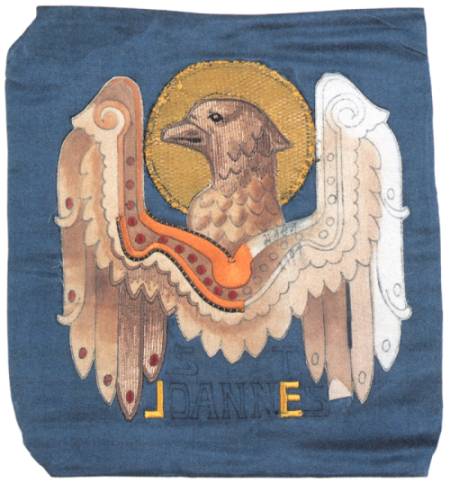 |
Pattern with eagle
and inscription IOANNES The embroidery is sewn into cotton material in order to waste as little of the costly silk fabric as possible. The close-up shows the white satin fabric with the printed and painted design. It is applied on the blue silk background. Now the design is going to be embroidered: all the golden parts and the "economising stitches" were done by hand. The Lorraine machine was used for the satin stitch sections. This close-up clearly shows us the second thread, which can be seen only on the reverse side. This example was not done on a Schiffli machine because the Schiffli machine would first completely finish the machine embroidered parts, and hand embroidered parts would be added only afterwards. Second: the ground fabric could be cut out only after the embroidery is completed but not before. |
The
Material: |
The embroideries of the Fraefel Company were dispersed all over the world. But the fotografic documentation gives an impression of the extent, the type and the style of his works: |
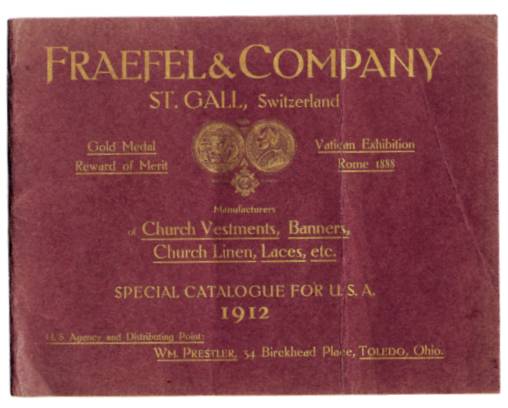 |
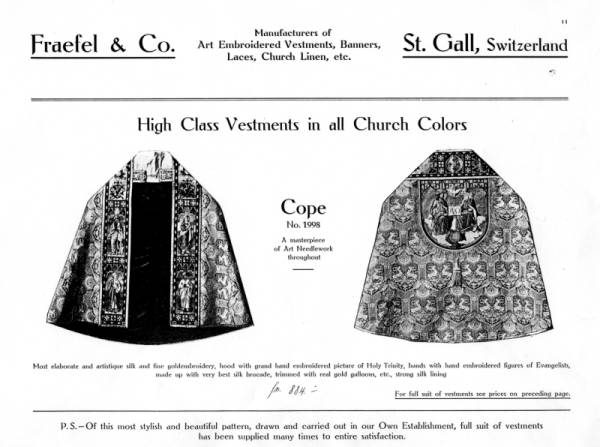 |
| Some embroideries of Frafel & Co. |
| Vestment at St.
Gallen a vestment consisting of 4 copes, 4 dalmatics, 1 chasuble is still being used in the cathedral of St. Gallen and it is signed Fraefel & Co. It had been made for bishop Augustinus Egger (bishop from 1882-1906) and it is the last vestment that was made for the cathedral of St. Gallen. |
A similar cope appears in
the printed catalogue for USA in 1912 (No. 2052). The
description is as follows: "Gran Cope of best silk Damask or heavy silk brocade, very rich and imposing silk and real gold embroidery, five pictures in Art needlework, fine real gold galloons and fringe, best silk linings". In another place of the catalogue it says: "hood with grand hand embroidered picture of Holy Trinity (No 1998)". |
| It seems that there was a
difference between art needlework and hand embroidery.The
emphasizing of hand embroidery, which was the most
expensive work of all, means on the other side, that art
needlework could also include machine work. All embroideries whether made by machine or by hand were made in series. Thus the company produed works of embroidery which could be reproduced many times. In the city of St.Gallen there existed for many years a vestment association. The members did their own hand embroideries, they would also very often buy material or individual parts from Fraefels and then add these parts to the vestments. So it is very likely that even the simpler and unsigned vestments of the later 19th and early 20th century were strongly influenced by the Fraefel manufactory. |
Hood from the
back of the Cope |
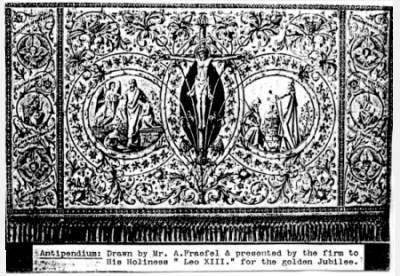 There
is only an old photograph preserved |
The Antependium
designed by Arnold Fraefel and hand embroidered, was made
for Pope Leo 13 (pope from 1878 - 1903). At present it is
not known whether this Antipendium is still in Rome. It
is possible that Fraefel was awarded a gold medal for
such a piece of work. In 1888 there was a Vatican
Exhibition in Rome and Fraefel & Co was awarded a
golden Medal, a reward of merit. |
| Fraefel | machines |
| content | Last revised July 16, 2004 |